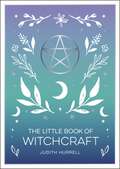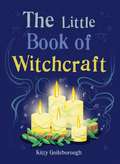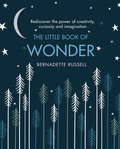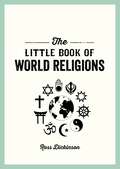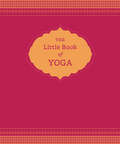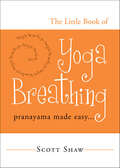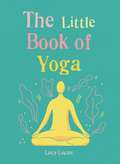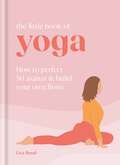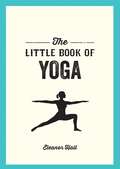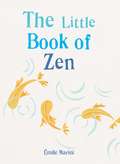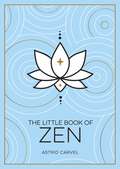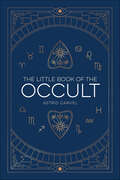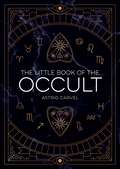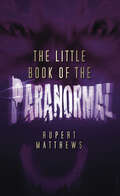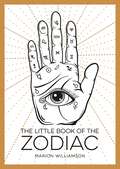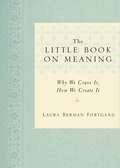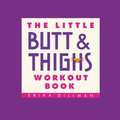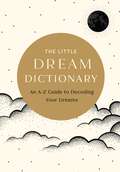- Table View
- List View
The Little Book of Witchcraft: An Introduction to Magick and White Witchcraft
by Judith HurrellDiscover the wonders of Wicca and learn how to harness your inner power with this beginner’s guide to white witchcraftFind your magick From the history of Wicca to the basics of spell work, this pocket-sized book is the perfect introduction to magick and white witchcraft. Find out how to tap into the infinite power of the natural world by uncovering the unique properties of natural ingredients – from herbs, flowers and seeds to incense and crystals. Study the extraordinary history of witches and Wicca, and discover how present-day witches combine modern technology and traditional methods to help manifest their desires. Master the rudiments of white magick with enchantments and rituals for every occasion.Whether you’re a budding witch or simply want to learn more about the world of spells and sorcery, this book includes everything you need to understand and start practising this remarkable craft.Enrich your life with the power of magick and learn how to:Uncover and embrace your inner witchConnect with the rich history of witchcraftStart developing your Wiccan abilities and sustain your craftWork in alignment with the earth’s natural rhythms to get the most out of your practiceCreate spells, potions and rituals for promoting love, happiness and success
The Little Book of Witchcraft: Explore the ancient practice of natural magic and daily ritual
by Kitty GuilsboroughDiscover the history of witches, experience the healing properties of crystals and learn simple daily incantation that will help you to shape your destiny.Witchcraft has existed since the days of Greek mythology and is now practiced as widely as other modern pagan religions. More than spells and incantations, witchcraft is a lifestyle that can help you relax, heal, and grow in confidence. With this guide, you'll learn the basics from assembling your own witch kit and getting to grips with tarot, to growing your own 'Witch Kitchen Garden'. Whether you want to learn more about rituals and magic, or if you just want to get in touch with your witchy side, The Little Book of Witchcraft will show you the way.In this book, magic writer Kitty Guilsborough shows you how to harness your inner power by unlocking the ancient art of witchcraft.
The Little Book of Witchcraft: Explore the ancient practice of natural magic and daily ritual
by Kitty GuilsboroughWitchcraft has existed since the days of Greek mythology and is now practiced as widely as other modern pagan religions. More than spells and incantations, witchcraft is a lifestyle that can help you relax, heal, and grow in confidence. With this guide, you'll learn the basics from assembling your own witch kit and getting to grips with tarot, to growing your own 'Witch Kitchen Garden'. Whether you want to learn more about rituals and magic, or if you just want to get in touch with your witchy side, The Little Book of Witchcraft will show you the way.In this book, magic writer Kitty Guilsborough shows you how to harness your inner power by unlocking the ancient art of witchcraft.
The Little Book of Wonder: Rediscover the power of creativity, curiosity and imagination
by Bernadette RussellWhen was the last time you felt 'wonder'? The feeling of amazement and admiration, caused by something beautiful, remarkable, or unfamiliar is one that, as children, we experienced often. But as adults we have grown tired and cynical and spend more time looking down at our phones than looking up at the sky. We no longer experience the power of awe nor its proven benefits.The Little Book of Wonder encourages you to be creative, feel curious and seek wonder in the world around us. Focussed around seven themes, echoing the seven wonders of the world, the book will explore:1. The Wonder of You2. Into the Woods3. Curious4. Magic5. Creativity6. The Road Less Travelled7. Positivity
The Little Book of Wonder: Rediscover the power of creativity, curiosity and imagination
by Bernadette RussellWhen was the last time you felt 'wonder'? The feeling of amazement and admiration, caused by something beautiful, remarkable, or unfamiliar is one that, as children, we experienced often. But as adults we have grown tired and cynical and spend more time looking down at our phones than looking up at the sky. We no longer experience the power of awe nor its proven benefits.The Little Book of Wonder encourages you to be creative, feel curious and seek wonder in the world around us. Focussed around seven themes, echoing the seven wonders of the world, the book will explore:1. The Wonder of You2. Into the Woods3. Curious4. Magic5. Creativity6. The Road Less Travelled7. Positivity
The Little Book of World Religions: A Pocket Guide to Spiritual Beliefs and Practices
by Ross DickinsonReligion flourishes around the globe in diverse forms, each uniquely fascinating and multifaceted, playing a central role in the lives of billions. From the five biggest faiths to the lesser-known creeds, this pocket guide offers an engaging introduction to world religions, exploring their history, beliefs, practices and personalities. It’s a starting point for anyone seeking deeper understanding of humanity’s spiritual side.
The Little Book of Yoga
by Nora IsaacsA concise overview of the ancient mind-body practice, covering the poses, history, philosophy, and more.The Little Book of Yoga offers a comprehensive foundation in the practice of yoga. It’s an engaging and approachable volume perfect for yoga lovers of all levels—beginner or advanced, committed or just curious. Beginning with a brief history of yoga and its various styles, Nora Isaacs presents instructions and illustrations for all the major poses. She also goes beyond the poses to discuss yogic philosophy, breathing, meditation, chakras, and more.
The Little Book of Yoga Breathing: Pranayama Made Easy…
by Scott ShawThe Little Book of Yoga Breathing is a great little package that offers a lot. Pranayama, the practice of breath control, is detailed here in an easy-to-understand and even easier-to-practice format. Professional yoga instructor, Scott Shaw introduces 16 breathing exercises and how to get the best benefit from each of the forms by training, refining, and witnessing your breath. This book is for yoga practitioners and those who only consider themselves yoga admirers. Having trouble falling asleep? Try one of the calming breaths, Nadi Sudi, or the Nerve Purifying Breath. Have a long day ahead with no breaks until after dinner? Allow Ujjayi or the Hissing Breath to work its miracles. Also learn the Pranayama term in Sanskrit, how to pronounce it, what it means in English, and how to properly execute the breath to get the best results. And learn how to breathe while moving, standing, and leaning, and how each of these variations can affect your breathing practice.
The Little Book of Yoga: Harness the ancient practice to boost your health and wellbeing
by Lucy LucasYoga is an ancient practice, harnessing the breath and strengthening the body to boost physical health and mental wellbeing. Whether you want to relax, become more flexible or get in touch with your spiritual side, this book will show you the way. Find out which type of yoga is right for you, experience the calming effects of yoga breathing techniques and learn simple daily practices that will make you feel strong, calm and focused.In this book, expert practitioner Lucy Lucas shows you how to integrate yoga into your life, simply, every day.
The Little Book of Yoga: Harness the ancient practice to boost your health and wellbeing
by Lucy LucasYoga is an ancient practice, harnessing the breath and strengthening the body to boost physical health and mental wellbeing. Whether you want to relax, become more flexible or get in touch with your spiritual side, this book will show you the way. Find out which type of yoga is right for you, experience the calming effects of yoga breathing techniques and learn simple daily practices that will make you feel strong, calm and focused.In this book, expert practitioner Lucy Lucas shows you how to integrate yoga into your life, simply, every day.
The Little Book of Yoga: How to Perfect 50 Asanas and Build Your Own Flows
by Lisa HoodYoga is a restorative, mindful and gentle practice that can strengthen your body while helping you centre yourself in the moment.Use yoga to relax, improve your flexibility, focus your mind and connect with your spiritual side just by gently easing your body into poses that boost your physical and mental wellbeing. With 50 poses to choose from and guidance on how to select the poses that suit your needs and how to move between them smoothly, the Little Book of Yoga teaches you how to wake up feeling energised, calm an anxious mind, sleep better and feel inspired.Whether you want to include a pose or two in your morning routine or want to combine the poses into a custom flow that's uniquely yours, the Little Book of Yoga will help you find the poses you need to stretch your body and support your spirit. Ideal for everyone from total beginners to more experienced yogis, this beautifully illustrated book includes everything you'll need to live a more balanced, grounded life. Begin today and reap the benefits for the rest of your life!Chapters include:- Warm-up- Warrior- Standing Balance- Seated- Backbend- Closing- Transition
The Little Book of Yoga: How to Perfect 50 Asanas and Build Your Own Flows
by Lisa HoodYoga is a restorative, mindful and gentle practice that can strengthen your body while helping you centre yourself in the moment.Use yoga to relax, improve your flexibility, focus your mind and connect with your spiritual side just by gently easing your body into poses that boost your physical and mental wellbeing. With 50 poses to choose from and guidance on how to select the poses that suit your needs and how to move between them smoothly, the Little Book of Yoga teaches you how to wake up feeling energised, calm an anxious mind, sleep better and feel inspired.Whether you want to include a pose or two in your morning routine or want to combine the poses into a custom flow that's uniquely yours, the Little Book of Yoga will help you find the poses you need to stretch your body and support your spirit. Ideal for everyone from total beginners to more experienced yogis, this beautifully illustrated book includes everything you'll need to live a more balanced, grounded life. Begin today and reap the benefits for the rest of your life!Chapters include:- Warm-up- Warrior- Standing Balance- Seated- Backbend- Closing- Transition
The Little Book of Yoga: Illustrated Poses to Strengthen Your Body, De-Stress and Improve Your Health
by Eleanor HallThere are plenty of reasons to try yoga – strengthen your body, soothe your soul, reduce stress and many more! This easy-to-digest guide has tips to help you get started and is packed with a variety of poses that target a range of abilities. Be inspired to enjoy all that’s best about an AWESOME YOGA LIFESTYLE.
The Little Book of Zen
by Émile MariniTreat the stresses of modern-day life with The Little Book of Zen. Who knew so much wisdom could come in such a small package? This little book is packed full of easy practices and meditations to help you introduce the principles of Zen Buddhism into your day-to-day: enhance your spiritual, physical and mental wellbeing, tune into your natural intuition, and find your inner calm. Beautifully presented, this book is the perfect introduction to this ancient practice.Contents:Chapter 1: The Overflowing Teacup and the Beginner's Mind Chapter 2: A Practical Guide to Meditation Chapter 3: The Moon in Water - Understanding What We Can't Understand Chapter 4: Every Day Is a Good Day - Zen and the Art of Suffering Chapter 5: Wash Your Bowl - Zen and the Physical World
The Little Book of Zen
by Émile MariniTreat the stresses of modern-day life with The Little Book of Zen. Who knew so much wisdom could come in such a small package? This little book is packed full of easy practices and meditations to help you introduce the principles of Zen Buddhism into your day-to-day: enhance your spiritual, physical and mental wellbeing, tune into your natural intuition, and find your inner calm. Beautifully presented, this book is the perfect introduction to this ancient practice.Contents:Chapter 1: The Overflowing Teacup and the Beginner's Mind Chapter 2: A Practical Guide to Meditation Chapter 3: The Moon in Water - Understanding What We Can't Understand Chapter 4: Every Day Is a Good Day - Zen and the Art of Suffering Chapter 5: Wash Your Bowl - Zen and the Physical World
The Little Book of Zen: A Beginner's Guide to the Art of Zen
by Astrid CarvelHow can we be happy?How should we treat others?How should we spend our time?Discover the path to peaceful living with this beginner’s guide to the ancient practice of Zen Zen is a philosophy for living in a state of kindness, gratitude and awareness, teaching us to be present and to experience the world as it truly is. This book will guide you through the concepts of Zen, revealing how you can apply its principles to your daily life and how you can reap the benefits to gain a greater sense of peace and calm. Through simple tips, guided meditations and thought exercises, you can learn to cultivate Zen, whether you’re new to the practice or have been familiar with it for years.Are you ready to discover the secrets of Zen?Within these pages you’ll find:The history of the Zen school of thought, and how it has shaped the world we live in todayAn introduction to Zen practices and beliefs, including the Six Virtues and the Five Precepts, and to Zen ceremonies, holidays and ritualsTips for cultivating and perfecting your practice, and developing your own sense of “Zen”Step-by-step instructions for trying various meditations and exercises for yourselfIdeas to make your daily life and home more ZenExercises in Zen arts, such as calligraphy, painting, gardening and flower arrangingWise words from the world’s most enlightened thinkersThought-provoking Zen teachings to help you see things in a new light
The Little Book of Zen: A Beginner's Guide to the Art of Zen
by Astrid CarvelHow can we be happy?How should we treat others?How should we spend our time?Discover the path to peaceful living with this beginner’s guide to the ancient practice of Zen Zen is a philosophy for living in a state of kindness, gratitude and awareness, teaching us to be present and to experience the world as it truly is. This book will guide you through the concepts of Zen, revealing how you can apply its principles to your daily life and how you can reap the benefits to gain a greater sense of peace and calm. Through simple tips, guided meditations and thought exercises, you can learn to cultivate Zen, whether you’re new to the practice or have been familiar with it for years.Are you ready to discover the secrets of Zen?Within these pages you’ll find:The history of the Zen school of thought, and how it has shaped the world we live in todayAn introduction to Zen practices and beliefs, including the Six Virtues and the Five Precepts, and to Zen ceremonies, holidays and ritualsTips for cultivating and perfecting your practice, and developing your own sense of “Zen”Step-by-step instructions for trying various meditations and exercises for yourselfIdeas to make your daily life and home more ZenExercises in Zen arts, such as calligraphy, painting, gardening and flower arrangingWise words from the world’s most enlightened thinkersThought-provoking Zen teachings to help you see things in a new light
The Little Book of the Occult
by Astrid CarvelAn exploration of rich history and a discovery of lasting benefits, The Little Book of the Occult is a quick dive into the world of occult magick, perfect for both beginners and those who are more familiar with the practice. From sigils to tarot cards and rituals, occult practices are an insightful way to achieve your dreams, discover more about yourself, and feel empowered.
The Little Book of the Occult: An Introduction to Dark Magick
by Astrid CarvelDiscover the wonders of occult magick and learn how to harness your witch powers with this beginner’s guideFrom summoning courage with a simple candle ritual, to seeing what the day has in store by reading the grounds from that first cup of coffee, occult magick has become part of daily life for many over recent years. The opportunity to glimpse the future – or learn from our past – holds a mystical allure as we try to make sense of the unpredictability of our existence.Occult practices are no longer associated with devil worship or summoning evil entities – they’re a fun and insightful way to achieve your dreams, discover more about yourself and others, and feel empowered.The Little Book of the Occult offers an introduction to this fascinating subject, exploring its rich history and its numerous potential benefits to health, wealth, love and relationships.You will discover how to:Develop your powers of perception by working with the pineal eyeRead what the future has in store by scrying with fire and waterPractise tarot with three- and one-card readings for yourself and othersManifest your dreams and desires by channelling the power of the universe
The Little Book of the Paranormal
by Rupert MatthewsThe paranormal is a subject of endless fascination to the book-buying public. There is an insatiable appetite for tales of UFOs, ghosts, bigfoot and other features of our world that are frequently reported by eye-witnesses, but are not yet accepted by science as being genuine phenomena or events. This little book introduces the reader to the world of the paranormal and entertains them with numerous anecdotes, snippets of information and lists of events. Rupert Matthews has produced an amusing, and yet serious volume that will leave the reader wondering just why scientists refuse to study the amazing world of the paranormal. The book is divided into eight chapters, including: UFOs and aliens, Bigfoot and man-apes, ghosts and hauntings, sea-serpents and lake monsters, predictions and curses, poltergeists, paranormal humans and 'going beyond' - which deals with near-death experiences and mediumship. This is a thought-provoking book covering all aspects of the paranormal in an accessible and entertaining way.
The Little Book of the Zodiac: An Introduction to Astrology
by Marion WilliamsonEmbark on a voyage of self-discovery with this spellbinding introduction to astrology. Learn ways to interpret your birth chart and how your star sign can tell you about your character traits. Let this book shine a light on your past, present and future, and reveal a deeper understanding of your celestial outlook.
The Little Book of the Zodiac: An Introduction to Astrology
by Marion WilliamsonEmbark on a voyage of self-discovery with this spellbinding introduction to astrology. Learn ways to interpret your birth chart and how your star sign can tell you about your character traits. Let this book shine a light on your past, present and future, and reveal a deeper understanding of your celestial outlook.
The Little Book on Meaning
by Laura Berman FortgangAn invaluable guide and companion for anyone seeking greater meaning and purpose in life. A nominee for the Books for a Better Life award! As a pioneer in the field of life coaching, Laura Berman Fortgang has spent decades helping people figure out what they want to do with their lives. And so it was a bit of a surprise when a theme she heard repeatedly from clients emerged in her own thinking and would not be dismissed: work didn't feel as "meaningful" to her as it once had. It was one of those big realizations one has from time to time. The funny thing was that it turned out the "solution(s)" to her problem were quite small... In The Little Book on Meaning Laura Berman Fortgang reveals that while our hunger for a meaningful life can be enormous, our desire for meaning is usually satiated by small, bite-size morsels of meaning-the small, almost incidental events or "achievements" that comprise the fabric of our lives. According to Fortgang, meaning is where you look for it, and through tenderly drawn stories from her own life and the lives of those around her, she shows readers how they too can peek around corners to discover the small elements of their lives that truly matter.
The Little Butt & Thighs Workout Book
by Erika DillmanFrom the "little book" series, a guide to getting the thighs and butt you want.
The Little Dream Dictionary: An A-Z Guide to Decoding Your Dreams
by Tim RaybornDive into a world of new insights and self-discovery as you unlock the secrets of your subconscious with this collection of 1,000+ common dream symbols and their meanings. Unlock the mysteries of your dreams with this comprehensive dream dictionary, featuring over 1,000 of the most common dreams and their interpretations. Whether you dream of being underwater, flying, or taking an exam, this handy guide offers insightful and straightforward explanations that illuminate the deeper meanings behind your dreams. Each concise entry will provide you with greater clarity and understanding of yourself and your subconscious thoughts, desires, and fears. Whether you&’re a dream enthusiast or a newcomer to dream analysis, this book is your essential companion. Decode the secrets of your dreams and unravel your subconscious with the turn of every page. GAIN NEW INSIGHTS: Uncover the layers of your subconscious and learn how your dreams reflect your desires, fears, and aspirations, providing you with valuable insights into your waking life. 1,000+ ENTRIES: Entries cover a wide range of the most common dreams, from falling to flying. EASY TO REFERENCE: Perfect for those new to dream interpretation, with alphabetized entries and simple-to-understand explanations. EYE-CATCHING DESIGN: In addition to being a practical and comprehensive resource for dream analysis, this dictionary is a high-quality, deluxe product with spot illustrations throughout. COMPACT AND DURABLE: Durable materials and a portable 5.75" x 8.25" size make this dictionary ideal for taking on overnight trips and fitting on a nightstand.
